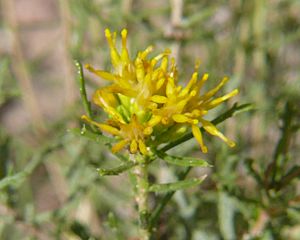Burroweed facts for kids
Quick facts for kids Burroweed |
|
|---|---|
 |
|
| Scientific classification | |
| Genus: |
Isocoma
|
| Species: |
tenuisecta
|
| Synonyms | |
|
|
Isocoma tenuisecta, often called burroweed, shrine jimmyweed, or burrow goldenweed, is a small, flowering plant. It is a type of perennial herb, which means it lives for more than two years. This plant is part of the sunflower family. You can find it growing naturally in Arizona, New Mexico, and Sonora in Mexico.
What Does Burroweed Look Like?
Burroweed plants typically grow to be about 1 to 3 feet (30–90 cm) tall. Their leaves are long and narrow, with many small teeth or lobes along the edges. These leaves also have tiny glands, which can make them feel a bit sticky.
This plant flowers in the fall, usually from September through November. It produces clusters of bright yellow flowers at the ends of its branches and on top of its main stem. Each flower cluster has 8 to 15 small yellow disc flowers. Unlike some other plants in the sunflower family, burroweed does not have the larger "ray flowers" that look like petals. After the flowers fade, the old heads turn dry and tan. They stay on the plant even after the seeds have spread.
Is Burroweed Safe?
It is important to know that burroweed can be harmful to animals, especially to livestock like cattle. If animals eat too much of this plant, it can make them sick. The harmful substances can even pass into milk from affected animals. So, it's best for animals to avoid eating burroweed.
Gallery
See also
 In Spanish: Isocoma tenuisecta para niños
In Spanish: Isocoma tenuisecta para niños



